Features
Fascinating Tanzania!
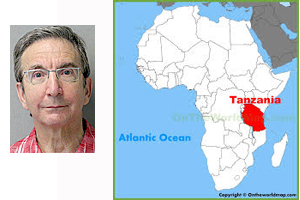
By MARTIN ZEILIG Our small motorized mangrove and mahogany canvas covered boat bounced along the choppy turquoise waters of the Indian Ocean as the captain and owner, Ahmed, manoeuvred the outboard engine towards Changuu Island, a small island about six kilometres northwest of Stone Town, Unguja Zanzibar.
As we sped along, a number of cargo ships and a Chinese fishing trawler were moored off shore, while long thin hulled dhows with billowing sails skimmed speedily on that sun searing day through the world’s third largest ocean.
I was at the tail end of my second trip to Tanzania in just over a year. The first trip was an eight day safari adventure in Northern Tanzania in June 2018. It was, as I wrote in a major two part article for the Lifestyles supplement of The Jewish Post & News afterwards, the fulfillment of a lifelong dream to go on safari in some of the big game parks, including the fabled Serengeti National Park, of East Africa.
This second trip in October 2019 was unplanned and unexpected. I was invited by a Canadian based representative of the Tanzanian government to attend the Swahili International Tourism Expo (S!TE), a three day event (October 18-20) held at the modern Julius Nyerere International Conference Center in Milimani City a region of Dar es Salaam, Tanzania. Dar es Salaam, which is situated on the Indian Ocean, is the largest city, former capital and commercial centre of Tanzania. The yearly event attracted 426 exhibitors, including safari tour operators from throughout Tanzania and other parts of Africa, and almost 1000 visitors over the three days. It also featured speakers, including representatives of the government of the United Republic of Tanzania.
I jumped at the opportunity. Why not? It also included a selection of four day side trips, or Familiarization Trips, afterwards to other parts of Tanzania. I chose to visit the historic town of Iringa and Ruaha National Park— the largest national park located in the middle of Tanzania and covering an area of about 13,000 square kilometres about 130 kilometres from Iringa. I also spent two days in Zanzibar upon returning from Ruaha.
Here are some other memorable moments:
The Expo centers around inbound and outbound travel business to and inside Africa. Tourism companies from 60 countries —Finland, Denmark, Lithuania, Ukraine, Malaysia, South Korea, Canada, India, among others — participated in the event.
“Protection and Sustainable tourism, and in addition tropical tourism and going inside East Africa, (is the goal of S!TE),” the Tanzanian Minister of Tourism, said during the opening address. “The tourism industry is here to help the economy of our country. Tanzania is a safari country in Africa. We are proud that Swahili was born in Tanzania. We encourage our foreign guests to see why we say, ‘Unforgettable Tanzania.’”
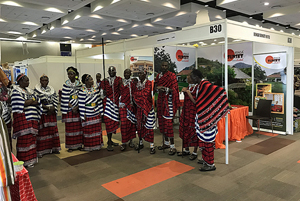 (at left): Being entertained by the Dar es Salaam based, Tot Jazz Band, one of the biggest jazz bands in Tanzania, at the opening entertainment event at SITE. They perform a fusion of Swahili jazz and more recognized numbers.Strolling along the shore of the Indian Ocean by my hotel, located on the outskirts of Dar, in the evening with the twinkling lights of yachts and merchant ships moored in the distance was a peaceful way to unwind after being at the hectic SITE all day. The surf’s fresh and salty smell combined with the exotic locale was intoxicatingVisiting the National Museum & House of Culture: It takes you on a journey through Tanzania’s colorful past. The museum displays important fossils of some of the earliest human ancestors unearthed during the Leakey digs at Olduvai Gorge. You can also learn about Tanzania’s tribal heritage and the impact of the slave trade and colonial periods. Other highlights of the museum include ethnographic displays on traditional crafts, customs, ornaments, and musical instruments, as well as a small collection of vintage cars, including the Rolls Royce used by former president, Julius Nyerere.
(at left): Being entertained by the Dar es Salaam based, Tot Jazz Band, one of the biggest jazz bands in Tanzania, at the opening entertainment event at SITE. They perform a fusion of Swahili jazz and more recognized numbers.Strolling along the shore of the Indian Ocean by my hotel, located on the outskirts of Dar, in the evening with the twinkling lights of yachts and merchant ships moored in the distance was a peaceful way to unwind after being at the hectic SITE all day. The surf’s fresh and salty smell combined with the exotic locale was intoxicatingVisiting the National Museum & House of Culture: It takes you on a journey through Tanzania’s colorful past. The museum displays important fossils of some of the earliest human ancestors unearthed during the Leakey digs at Olduvai Gorge. You can also learn about Tanzania’s tribal heritage and the impact of the slave trade and colonial periods. Other highlights of the museum include ethnographic displays on traditional crafts, customs, ornaments, and musical instruments, as well as a small collection of vintage cars, including the Rolls Royce used by former president, Julius Nyerere.
Iringa: Iringa is a city in Tanzania with a population of 1,211,900 (as of 2020), according to Wikipedia. The name is derived from the word lilinga, meaning .
Iringa is the administrative capital of Iringa Region. Iringa Municipal Council is the administrative designation of the Municipality of Iringa. “Iringa has been one of the coldest regions in Tanzania due to its geographical location but that has attracted a lot of tourists from colder regions abroad especially Western Europe,” notes online information. Iringa also hosts one of Africa’s largest national parks, the Ruaha National Park.
We also visited the Isimila Stone Age site, which lies about 20 km (12 mi) to the southwest. It contains archeological artifacts, particularly stone tools, from human habitation about 70,000 years ago. Homo Erectus lived here 300,000 years ago.
Excavation work was done by paleontologists from the University of Chicago, 1957-58; University of Illinois, 1968-70, and South Korea in 2003. Scrapers, slingshots, knives from stones, and different weapons were found and can still be seen in large open sided enclosures.
Iringa Region is home to the Hehe people.
“After their stunning defeat at Lugalo by the Hehe on August 17, 1871, led by Chief Mkwawa, the Germans built a military station at ‘Neu Iringa’ to avenge the death of their commander Emil Von Zelewski and to teach the Hehe respect for German authority,” says information in the Iringa Boma – Regional Museum and Cultural Centre. “The fortress and headquarters of Chief Mkwawa was in the nearby village of Kalenga, Alt Iringa.” It was only in July 1898, after being trapped, that Mkwawa shot himself. The Germans removed Mkwawa’s head and sent it to Germany.
Mkwawa still has “the status of a national hero in Tanzania,” even after over 120 years. A movie should be made about this man.
Ruaha NP: Ruaha is in a northern and southern transition zone.  Ruaha National Park is the largest national park in Tanzania. It covers an area of about 13,000 square kilometres.
Ruaha National Park is the largest national park in Tanzania. It covers an area of about 13,000 square kilometres.
It is located in the middle of Tanzania about 130 kilometres from Iringa. The park, which is located in the Great Rift Valley (East African Rift), is part of a more extensive ecosystem, which includes Rungwa Game Reserve, Usangu Game Reserve, and several other protected areas.
The name of the park is derived from the Great Ruaha River, which flows along its South-Eastern margin and is the focus for game-viewing.
The park can be reached by car via Iringa and there is an airstrip at Msembe, park headquarters.
I was part of a group that included three Dutch journalists. Our safari driver/expert guide, Serafino, was the owner of the Center for Research and Action, Limited (CRA)– a new company that started in 2019– in Irigina.
During our two days exploring Ruaha we encountered lions– including a male and female that mated several times as we clicked away on our cameras or cell phones– resting under a baobab tree and along a dry river bed; a beautiful male leopard nestled in the shade of an acacia tree a few hundred metres away from the lions; elephants, Cape buffalo, zebra, giraffes, elands and more. Ruaha is believed to have the highest concentration of elephants of any National Park in East Africa.
And it’s home to over 10 percent of Africa’s entire lion population, which is estimated to be only about 20,000 animals whereas about a century ago there were more than 200,000 lions in Africa, according to the World Atlas online. The International Union Conservation of Nature, though, has estimated that there might be as many 30,000 wild lions left on the continent. “From 1993 to 2014, the planet lost 43 percent of its population of African lions, conservationists estimate,” says National Geographic magazine (October 2019).
The park is home to the Ruaha Carnivore Project, which was established in 2009 by Dr. Amy Dickman, as a Kaplan Senior Research Fellow under Oxford University’s Wildlife Conservation Research Unit, says the RCP website.
“Ruaha’s Carnivore Project’s work in protecting lions and livestock, and helping local tribes, is clearly a win-win situation,” Sue Wats, an award-winning writer who specializes in African travel and conservation, wrote in an online article, How the Ruaha Carnivore Project is saving Tanzania’s Lions (SafariBookings).
It is also a place where magnificent mammals like Kudu, Sable and Roan antelopes can easily be spotted in Miombo woodland. The park is also a habitat for endangered wild dogs, although we didn’t see any. Other animals in the park include cheetah, giraffes, zebras, impala, bat eared foxes and Jackals.
The park also harbours a number of reptiles and amphibians such as crocodiles, poisonous and non-poisonous snakes, monitor lizards, agama lizards and frogs. We also spotted hippos relaxing in the Great Ruaha River. Ruaha is famous for being “Tanzania’s bird paradise” because more than 570 species of birds have been identified inside its boundaries, and some of them are known to be migrants from within and outside Africa, says information in a the park’s headquarters.
At one point on our bouncy dusty ride in the Land Rover, Serafino stopped at the side of the narrow dirt road. He got out of the vehicle and grabbed a handful of still steaming elephant dung, and told us all about its different uses by villagers. He then broke it open to reveal insects that were using the manure as a food source and to lay their eggs.
“When I stop for animals and trees and dung, it’s best for guests to listen carefully,” Serafino said afterwards. “It’s better to share with my guests.”
“It was gross, but interesting,” said fellow traveller Noel Vanbemmel, editor of the Travel section in the Dutch newspaper De Volkakrant, the biggest serious newspaper in Holland. “I’ve been on many safaris in sixteen different African countries, but this was the first time I’ve seen this demonstrated. He was doing his best.”
I booked my two day tour to Zanzibar at the SITE with Hassan Luzuba Majid, the owner of Hazaim Holiday and Safaris. His company is based in Zanzibar City (or Zanzibar Town or Stone Town, often simply referred to as Zanzibar)–the capital and largest city of Zanzibar, in Tanzania. It is located on the west coast of Unguja, the main island of the Zanzibar Archipelago, roughly due north of Dar es Salaam across the Zanzibar Channel.
My boat trip was onboard a super fast twin turbine powered ferry boat operated by Azam Marine Boats in Dar. The trip took a little over two hours.
I stayed at the not too pricey exotically named Golden Tulip Boutique Hotel. The rooms are spacious and the service is first rate.
Its open rooftop restaurant has a stunning view of the harbour.
Among the places I visited were the Jozani Forest, the largest area of indigenous forest on Zanzibar Island. Situated south of Chwaka Bay on low-lying land, the area is prone to flooding, which nurtures a lush swamp like environment of moisture-loving trees and ferns. Josanzi is the home of rare Red Colobus Monkey, which is only endemic to Zanzibar. We also spotted some grey and black monkeys.
The nearby Jambo Spice Plantation, about 12 acres in size, is owned by three families. This is a demonstration farm where you can see all different varieties of spices grown in Zanzibar. This farm is only for demonstration system.
Changuu Island saw use as a prison for rebellious slaves in the 1860s and also functioned as a coral mine, say the historical markers.
The British First Minister of Zanzibar, Lloyd Mathews, purchased the island in 1893 and constructed a prison complex there. But, it never held prisoners. Instead it became a quarantine station for yellow fever cases. The station was only occupied for around half of the year and the rest of the time it was a popular holiday destination. Visitors are able to explore the old prison and even stop for refreshments at an outdoor restaurant.
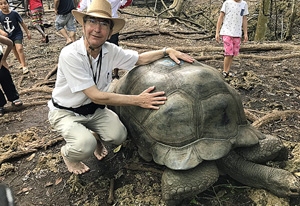 Spending time, along with other tourists, amongst the 200 giant Aldabra tortoises on Changuu Island was a wondrous experience. In 1919 the British governor of Seychelles sent a gift of four Aldabra giant tortoises to Changuu from the island of Aldabra, say information signs. These tortoises bred quickly and by 1955 they numbered around 200 animals. The Zanzibar government, with assistance from the World Society for the Protection of Animals- Now known as World Animal Protection– built a large compound for the protection of the animals and by 2000 numbers had recovered to 17 adults, 50 juveniles and 90 hatchlings.
Spending time, along with other tourists, amongst the 200 giant Aldabra tortoises on Changuu Island was a wondrous experience. In 1919 the British governor of Seychelles sent a gift of four Aldabra giant tortoises to Changuu from the island of Aldabra, say information signs. These tortoises bred quickly and by 1955 they numbered around 200 animals. The Zanzibar government, with assistance from the World Society for the Protection of Animals- Now known as World Animal Protection– built a large compound for the protection of the animals and by 2000 numbers had recovered to 17 adults, 50 juveniles and 90 hatchlings.
Their ages are painted in blue on their shells.
“The oldest right now is 195 years old,” said my outstanding guide in Zanzibar, Nemes Raphael. “The youngest brother is 161 years old, but bigger in size.”
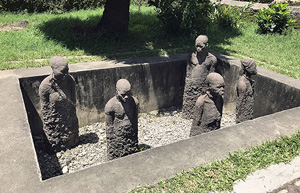 Old Stone Town is a UNESCO World Heritage Site. It’s narrow, meandering streets mean that pedestrians vie with motorized vehicles for the right of way.
Old Stone Town is a UNESCO World Heritage Site. It’s narrow, meandering streets mean that pedestrians vie with motorized vehicles for the right of way.
I also took a tour of the former slave market site. On June 6, 1873 the slave trade was officially abolished in East Africa. The slave trade continued underground, though, until 1909. It’s a sobering and claustrophobic experience to spend even a short time in the dank dungeons from the 16thcentury where slaves were squashed together under inhumane conditions before being taken to market for sale. The slaves from West Africa were sent to America. Those from East Africa were sent to Arab countries.
In 1869, Bishop Edward Steere from England settled in Zanzibar. Along with some British missionaries, Bishop Steere purchased the site of the slave market and began building the Anglican Christ Church there.
“He didn’t like the selling of slaves,” my guide at the site, Freddy, said. “He decided to go to the slave market. After purchasing slaves, he would teach them the bible and convert them to Christianity and then set them free. This is history. It’s very terrible. Sometimes I feel pain. My ancestors were among those who were set free from slavery by Bishop Steere.”
Having just seen the movie Bohemian Rhapsody, I visited Freddie Mercury House, which is now the Tembo House Hotel, on Kenyatta Road in Old Stone Town. Mercury, the former lead singer of Queen, was born in Zanzibar in 1946 where his name was Farrokh Bulsara. His father worked for the British colonial service and the family lived in various locations in Stone Town before immigrating to England.
Meanwhile, Forodhan Park is a busy seafood night market with n open sea front garden where people wait for friends or colleagues who are either arriving or leaving on the ferry.
I crammed so much into my two day visit to Zanzibar.
Tanzania is unforgettable.
Features
Is This the End of Jewish Life in Western Countries?
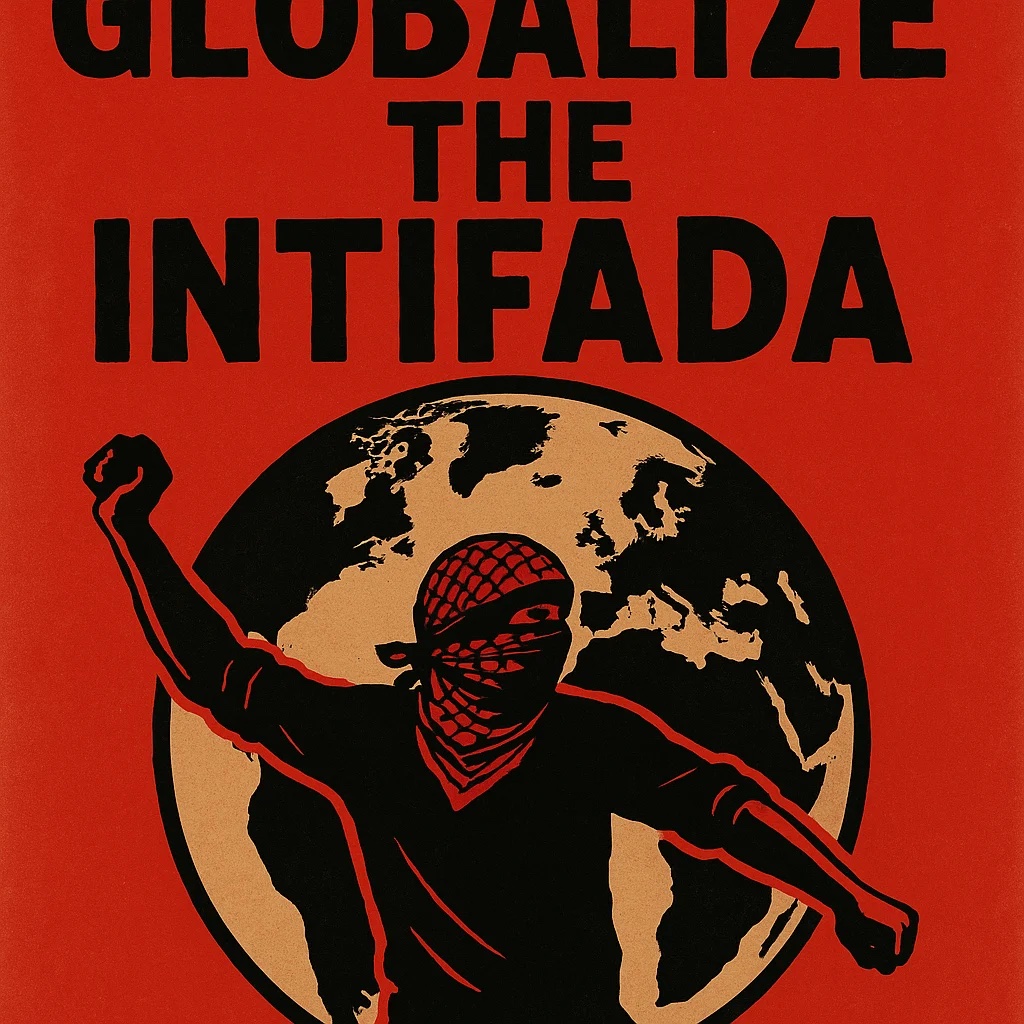
By HENRY SREBRNIK “Globalize the Intifada” has been the chant echoing through streets since October 7th, 2023. It was never a metaphor, and we now see the gruesome results across the western world, from Australia to Canada: the rise of groups of large, active networks of Islamist and anti-Zionist organizations.
Jews in the West are discovering that the nations they defended, enriched, and profoundly shaped have become increasingly inhospitable. After the Holocaust, explicit Jew-hatred became unfashionable in polite society, but the impulse never disappeared. The workaround was simple: separate Zionism from Judaism in name, then recycle every old anti-Jewish trope and pin it on “the Zionists.”
We have seen the full legitimization of genocidal anti-Zionism and its enthusiastic adoption by large segments of the public. The protests themselves, as they began immediately on October 7th, were celebrations of the Hamas massacres. The encampments, the building occupations, the harassment campaigns against Jewish students, the open calls for intifada, the attacks on Jews and Jewish places have become our new norm. History shows us that antisemitism does not respond to reason, incentive or the honest appeals of the Jewish community.
Outside the United States, there is no Western political establishment with either the will or the capability to address this problem, let alone reverse its growth. I’m sorry to say this, but the future of Western Europe, Canada, Australia, and New Zealand is likely to be increasingly Jew-free.
Today, police stand and watch mobs chant for Israel’s destruction, call for the genocide of its people, harass visibly Jewish citizens, and drive antisemitic intimidation deep into urban life. They now believe their job is to enforce the law only if it does not risk upsetting violent constituencies. This makes Jews expendable, because defending them risks confrontation. This was very clear in the Bondi Beach massacre.
Jews are again donning caps instead of kippot, dressing generically with no cultural markers, and avoiding even a tote bag with Hebrew on it. A corrosive creep toward informal segregation in retail and service sectors is occurring, as Jewish customers report being refused service. A mezuzah hanging from a rideshare mirror leads to cancellations. When Jews express frustration, they are accused of exaggeration or attempting to suppress criticism of Israel. Jewish fear is not treated as a real problem.
“Jews Are Being Sent Back into Hiding,” the title of a Dec. 15 article in the New York Free Press by David Wolpe and Deborah Lipstadt, asserts that the attacks on Jews, including physical assaults, social media campaigns and, most tragically, the recent murders in Australia, are part of a purposive campaign designed to make Jews think twice about gathering with other Jews, entering a synagogue, going to kosher restaurants, putting a mezuzah on the doorpost of their apartments or dorm rooms, or wearing a Jewish star around their necks.
“We know of no one who would consider giving a niece, nephew, grandchild, or young friend a Jewish star without first asking permission of their parents,” they write. The unspoken, and sometimes spoken, question is: “Might wearing a star endanger your child’s well-being?”
Recently, a prominent American rabbi was entering a Target store in Chicago with her grandson, whom she had picked up from his Jewish day school. As they walked into the store the 10-year-old reached up and automatically took off his kippah and put it in his pocket. Seeing his grandmother’s quizzical look, he explained: “Mommy wants me to do that.”
Borrowing a phrase from another form of bigotry, they contend that Jews are going “back into the closet.” No public celebration of Hanukkah took place in 2025 without a significant police presence. Some people chose to stay home.
Lipstadt and Wolpe know whereof they speak. They are respectively a professor of history and Holocaust studies who served as the Biden administration’s ambassador tasked with combating antisemitism, the other a rabbi who travels to Jewish communities throughout the world, and who served on Harvard’s antisemitism task force in the aftermath of the October 7, 2023 pogrom.
What the world has seen over the past two years is a continual, often systematic attempt to terrorize Jews. When political leaders fail to condemn rather than merely “discourage” chants of “globalize the intifada,” we are seeding the ground for massacres like the Hannukah one in Sydney.
If each Jewish holiday will now be seen by antisemites as an opportunity for terror, then the prognosis for diaspora Jewry is bleak. There will be fewer public events, more alarms, more bag checks at doors; there will have to be more security and more police. Unless things change, Jewish life in the diaspora will become more sealed off from the larger society.
Why has this failure come about? Confronting antisemitism, stopping the mobs, challenging the activists, and disciplining antisemitic bureaucrats all carry electoral risk for politicians; Jews are demographically irrelevant, especially compared with Muslim voters, with the U.S. being the only partial exception.
There are those who suggest Jews stop donating funds to educational and other institutions that have turned against us. At this point, I doubt very much that withdrawing dollars will have an impact. For every dollar withdrawn, there will be 100 from Qatar and other sources in its place.
Throughout history, the way a society treats its Jews predicts its future with unerring accuracy. If Jews leave, it will be because a civilization that will not defend its Jews will also defend next to nothing and may itself not survive.
Henry Srebrnik is a professor of political science at the University of Prince Edward Island
Features
Canadian Travel Trends 2025 and the Forecast for 2026

Canadians planning to travel in 2026 should keep an eye on shifting trends and learn what’s coming their way in the new year.
Canadian travel has seen a fair amount of change and instability over the last few years, thanks mostly to the country’s southern neighbours. In 2025, and likely into 2026, travel trends in the Great White North have stabilized significantly, with more Canadians than ever choosing to travel within their own borders. And with 2026 nipping at our heels, let’s take a look at what trends in 2025 have been the most prevalent and how these will shape travellers’ decisions and travel plans in the new year.
Canadian Travel in 2025
Thanks to many factors, including politics, inflation, and airline competition, the majority of travellers opted to explore their own country rather than go abroad in 2025. More local travel money is remaining within the local economy, further bolstering it and making it an even more attractive travel choice. Thanks to the accessibility of private jet charter travel across Canada, luxury local travel has increased as well, with more people looking to immerse themselves in luxury from the start of their journey to the end. When travelling abroad, the U.S. is now the least favoured destination for most Canadian travellers, but Europe saw a significant increase in interest as 2025 progressed.
As local Canadian travel increased this year, it brought with it a drive for local tourists to find their own “Secret Canada” destinations. Far more “off the beaten path” trips were taken, resulting in more travel spending going to smaller or more boutique destinations rather than big city experiences. In 2025, travellers have sought out the wonderful diversity in destinations and landscapes, allowing themselves to access more grounded and authentically Canadian experiences.
Canada’s Government has also encouraged and benefited from local tourism, with initiatives like the Canada Strong Pass offering extra benefits. Initially implemented in the summer, but reintroduced from December 12, 2025, until January 15, 2026, this is a ticket to enjoying the richness of their own culture (iconic natural destinations, museums, train trips) at a discounted rate or even in some cases free of charge.

In the second quarter of 2025, locals took a total of 90.6 million trips that included at least some time spent travelling domestically, which indicated a rise of 10.9% on a year-over-year basis. Of these trips, 58.6 million were day trip experiences (an increase of 12.4%), and 32.0 million were overnight trips or longer (an increase of 8.4%).
Between April and June of this year, Canadian residents spent $20.3 billion on local tourism, which represented a 13.5% year-over-year increase. When undertaking day trips, Canadians spent approximately $101 per visit. On overnight trips, locals spent around $449 per trip, with an average trip length of 2.6 nights. The Great White North is clearly holding its own, and then some, in the international travel market.
Canadian Travel in 2026
As we move towards 2026, many trends from 2025 will remain the standard, but some will evolve to fit changing demands. Across the board, though, the outlook for the coming year is that Canadian travel will become a far more personal thing, with trips being customized to fit travellers’ requirements and desires more closely than ever before. From choosing a hotel that they feel smacks of a beloved destination in their favourite novel, to taking a trip to a destination just to try a snack that’s famously made there and only there, travel is stretching and shifting for the traveller rather than the other way around.
Here are some slightly more specific predictions for the coming year based on the answers of polled Canadians.
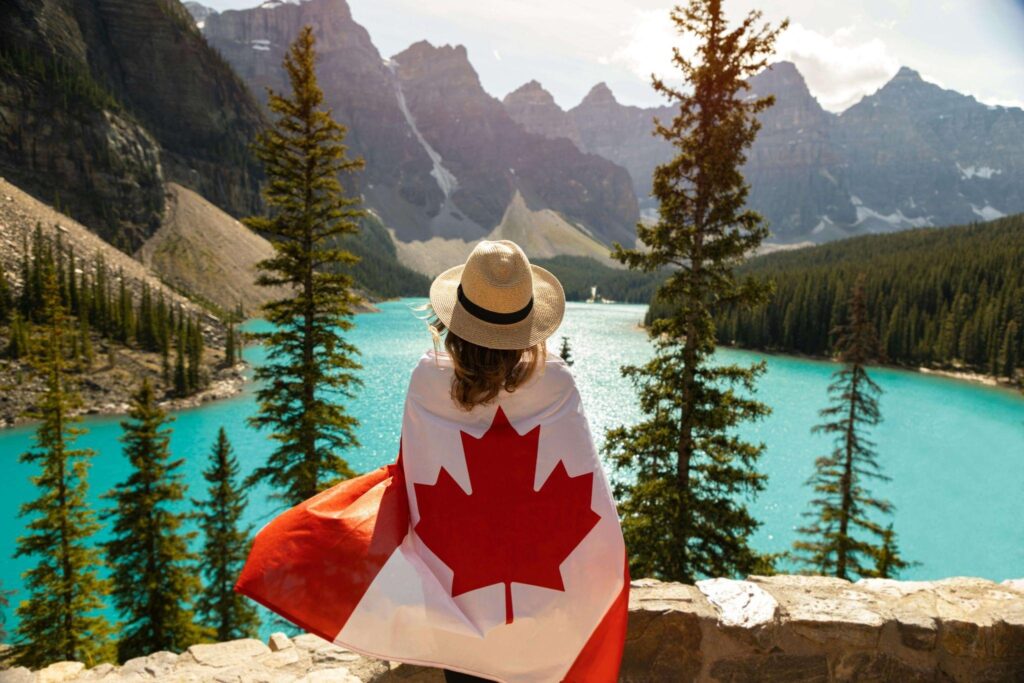
- One Gen Z-led trend is the idea of “glowmad travel”. Beauty and skincare are now influencing the places that Gen Z travels, and their trips are far more likely to include visits to skincare and beauty destinations like spas and luxury stores.
- Gen Z adults are helping to drive another trend: family travel as a way to save money. 345 of Gen Z adults polled say that they would take this route.
- More than 70% of Canadians are considering some sort of mountainous getaway in 2026, specifically in summer or autumn.
- 48% of polled Canadians say they would book or consider a destination thanks to the influence of literature.
- More travellers than ever are choosing their destinations based on the accommodations available. 44% of polled travellers say that in 2026, accommodation and what it can offer comes first, and the surrounding destination comes second.
The World Is Your Nova Scotia Lobster Roll
Choose something a little different when you vacation this year. Oysters are great, but a Nova Scotia lobster roll might be more to your taste! Canadians know good travel, so take a maple leaf out of their book and experience something new this year.
Features
Fake IDs and Underage Bettors: The Growing Problem for Sportsbooks
The expansion of legalized sports betting worldwide has resulted in sportsbooks grappling with a problem that they can no longer overlook: the increase in underage individuals using counterfeit identification to place bets. As more and more ways to bet through mobile apps and online sign-ups emerge, minors who are set on their goal are inventing ways to get around age limits. The emergence of this trend is a breach of the law and morality; however, it is also an enormous problem that threatens the very existence of the platforms, which are forced to rigorously obey the regulations .
Why Fake IDs Are Becoming More Sophisticated
Conventional fakes used to be quite simple to recognize—low-quality printing, different fonts for the text, and inconsistent holograms would make them not very reliable for any kind of verification. But counterfeit documents have changed significantly over time. Nowadays, fakes are made better with the help of printing technology and software, and they can even copy barcodes and other scannable features, so their IDs look almost real.
This fact complicates things significantly for sportsbooks, especially those operating online. Most of the time, automated identity verification systems capture a user’s photo and perform basic data matching. In cases where a very good fake ID is used by a teenager who looks older, some systems cannot recognize the trick. Therefore, young bettors have found ways to be able to place wagers through these loopholes.
The Influence of Social Pressure and Online Culture
Social media is a major factor in the increase in risky behavior that minors are engaging in. On various platforms such as Instagram, TikTok, and Reddit, teenagers come across betting slips, parlay wins, and big-payout screenshots that are shared, most probably, by other users. The glamorization of sports betting is leading young people to copy the behavior of influencers, older friends, or even celebrities, as they think that it is the right thing to do.
The competitiveness usually associated with sports is one of the reasons some minors decide to bet on sports. For many, betting becomes another way to engage as a fan—by predicting outcomes, challenging friends, and experiencing the same excitement that adult fans enjoy. Unfortunately, only a small number of minors fully understand the financial risks involved, making them more vulnerable to developing harmful patterns that could continue into adulthood. This is why choosing the most responsible sportsbook, which you can discover more here, is essential. Such platforms provide guidance, enforce safe practices, and ensure regulated play, allowing fans to engage with sports betting in a more informed, secure, and controlled manner.
Sportsbooks Facing Regulatory Pressure
The sportsbooks are being given the task of more closely monitoring and preventing minors from betting on their platforms. If they fail, harsh penalties are possible, including severe fines, loss of a gambling license, and negative publicity that undermines a brand’s trustworthiness. As a result, it is becoming increasingly difficult for people to verify their identities, although this also inconveniences those who are, in fact, legitimate users.
Sportsbooks have to decide between two options that are in conflict with each other: on the one hand, they have to keep the registration process as simple as possible, and on the other hand, they have to carry out age verification in a very thorough manner. The work of balancing is tough, and the underage gamblers are trying all methods to find a way out.
The Rise of Identity Fraud Services
An alarming trend is the emergence of online vendors who openly advertise fake IDs and identity documents. These vendors often claim their products can pass standard sportsbook checks. Some even tailor IDs to specific regions, knowing that certain provinces, states, or countries use verification systems that rely heavily on image comparison rather than live validation.
The availability of these fraudulent services not only empowers minors but also exposes sportsbooks to risks related to stolen identities, money laundering flags, and fraudulent accounts that may later become legal liabilities.
The Consequences for Underage Bettors
While a minor might think that gambling is just a bit of fun without any harm, the outcome can be quite serious. If there is a catching, accounts are closed right away, winnings are confiscated, and parents or guardians, in some cases, are made legally liable for any financial disagreements. Besides that, the risk of developing a gambling problem in the future increases with early exposure to gambling, especially since teenagers are more impulsive and less capable of handling financial risks.
The majority of minors are not aware that sportsbooks keep very detailed records of their activities, including device information and IP addresses. In case a fake ID works one time, using it multiple times will definitely lead to getting caught.
A Growing Problem That Requires Joint Action
Fake IDs and underage betting are issues that have become a major challenge in the industry, and no single stakeholder can solve these problems on their own. Sportsbooks need to enhance their identity verifications, regulators should get prepared for new types of fraud, technology providers have to come up with new solutions more quickly, and parents should always be aware of what their children are doing online. The industry’s rapid development is making this problem more and more urgent because the number of minors trying to get around the safety measures is increasing.
Sports betting can serve as a fun and legal form of entertainment for adults, but the need to protect the youth is what defines the industry and ensures its survival in the long run. As the quality of fake IDs keeps improving and the online culture is more and more inclined to consider betting as a normal activity, sportsbooks must ensure that underage users do not have access and that the environment is safe for all users. They need to do this now more than ever.


